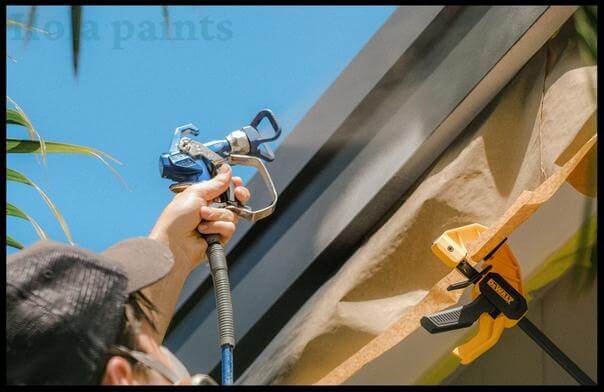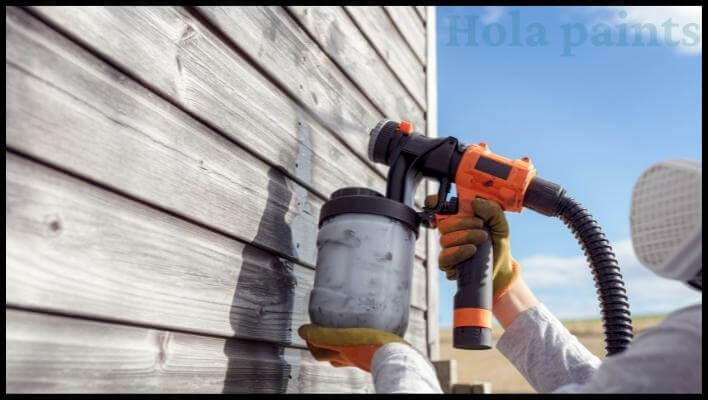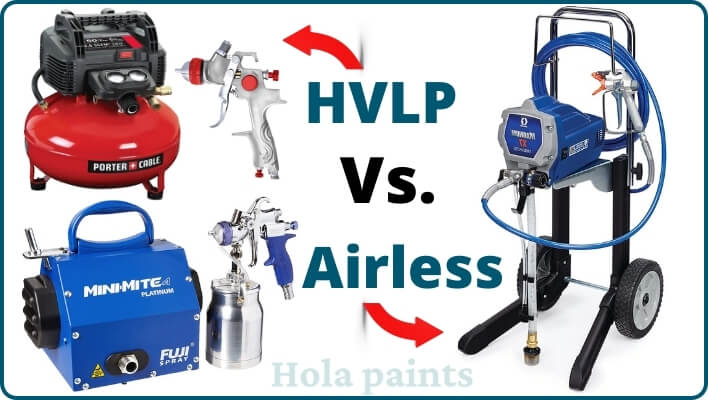Revamping your home is everyone’s wish, and painting with an airless sprayer has made it like a piece of cake. It’s a handy device and helps you paint even large areas quickly. It offers a uniform coating and is considered one of the best ways for interior or exterior painting.
If you are planning to paint using an airless sprayer, let me share my recent experience. I recently completed a large painting project for one of my old clients. The house was not in good condition; therefore, I chose to paint it with an airless paint sprayer. It took about a complete day to clean the walls and remove the old paint. Fortunately, an airless paint sprayer does not require much preparation. Finally, it took about 2 days to complete the whole project. The purpose of sharing this story is that an airless paint sprayer is a convenient way to paint, but don’t forget to buy the best paint for the airless sprayer.
Stay with us if you are stuck on the procedure to paint using an airless paint sprayer. I have discussed the procedure, settings, and everything crucial about the airless paint sprayers. Let’s get deeper!
Table of Contents
- What Is Airless Spraying?
- How Does an Airless Paint Sprayer Work?
- How To Use Airless Paint Sprayer Interior?
- Step 1: Prepare The Surface
- Step 2: Prepare The Paint
- Step 3: Hold The Sprayer and Practice
- Step 4: Adjust The Sprayer’s Pressure
- Step 5: Hold The Sprayer At A Certain Distance
- Step 6: Paint The Surface
- Step 7: Finalize The Paint
- Step 8: Apply Second Coat
- Airless Sprayer Pressure Settings
- What kind of paint can you use in an airless sprayer?
- What is the difference between conventional spray application and airless spray application?
- Airless Paint Sprayer Tips Tricks
- Is An Airless Paint Sprayer Worth It?
- Is It Hard To Use An Airless Paint Sprayer?
- FAQs On Painting with An Airless Sprayer
- Do airless sprayers use more paint?
- Is it good to spray latex paint with airless sprayer?
- Do I need to thin paint for an airless sprayer?
- Final Words On Painting with An Airless Sprayer
What Is Airless Spraying?

Airless spraying is a new technique to do indoor and outdoor painting without the use of air. This method is highly beneficial and simplifies the overall painting process. You get uniform paint on the walls and ceilings regardless of the project.
How Does an Airless Paint Sprayer Work?

As the name suggests, it does not use air for working, but the pressure is achieved by a dedicated pump. The standard pressure produced by the motor is about 3000 psi which you see mostly in Graco Magnum models like X7, X5, X17, except Graco Magnum project painter which is 2800 psi. The pressure is transferred to the hose. A small nozzle allows the paint come out of the nozzle.
Nowadays, airless spraying is preferred due to uniform results. They provide an all-in-all protection against corrosion, peel-off, fade-off, and other harmful effects.
| Pros | Cons |
| 1. Faster Paint Application | 1. Cleaning Process Takes Longer |
| 2. Efficient Material Coverage | 2. Overspray Can Lead to Wasted Paint |
| 3. Material Remains on the Surface | 3. Potential for Environmental Impact |
| 4. Suitable for High or Hard-to-Reach Areas | |
| 5. No Additional Masking Required | |
| 6. Suitable for Dark and Textured Surfaces |
How To Use Airless Paint Sprayer Interior?
Airless paint sprayers are a convenient and immediate alternative to performing a painting job consistently. Indeed you get better and more efficient results than other tools, i.e., paintbrush or roller.
Spraying latex paint with an airless sprayer like Krause and Becker sprayer is not easier till you know the right procedure. You need to check and adjust a few parameters. Don’t worry! We have shared the steps for how to use an airless paint sprayer in the following:
Step 1: Prepare The Surface
It’s necessary to prepare the surface before using a DIY airless paint sprayer. Preparation is also necessary in the adjoin area where you want paint. Suppose you have some areas that you don’t want to paint, cover them properly via masking tape. Lay some sheets or tarp on the floor to prevent drips from falling on the floor.
Step 2: Prepare The Paint
Buy high-quality paint from the market and prepare it. It doesn’t matter whether you want to use water-based or oil-based paint; make it thin enough to pass through the sprayer nozzle. Thick paint does not give uniform painting results. In short, the paint should be light enough that it does not leave drips on the surface.
Step 3: Hold The Sprayer and Practice
When you are a beginner or using the airless sprayer for the first time, it’s crucial to practice. For this, hold the airless sprayer in hand, press the trigger, and try to act like you are painting. Move the sprayer at different angles and in all directions. A few minutes of practice will be enough for you.
Step 4: Adjust The Sprayer’s Pressure
Paint adjustment is obvious to get an even paint finish. The best and most convenient way is to spray the paint somewhere and check the finish. Adjust the pressure till you get your required paint finish. On the other hand, you can read the manufacturer’s instructions for pressure adjustments.
Step 5: Hold The Sprayer At A Certain Distance
Hold the airless paint sprayer in your hands and maintain a distance of 10-12 inches between the walls and the sprayer’s tip. It’s the standard distance to apply the paint effectively and evenly. If you go far enough or closer, the finish will disrupt.
Step 6: Paint The Surface
Press the trigger and paint the surface in a uniform manner. Select one pattern, i.e., left to right or up to down, and follow it on the whole surface. Paint with a consistent speed and move the hand with relative speed. When you don’t see even look, adjust your hand movement.
Step 7: Finalize The Paint
Release the trigger and finalize the paint. Make sure the finish is even everywhere. Check the uniform painting from a distance and apply paint if something is still missing.
Step 8: Apply Second Coat
You have to wait for about 24 hours before the second coat. The paint finish will not be even when you don’t wait long. Otherwise, the paint finish will be thicker. Congrats! You have done painting with an airless sprayer.
Airless Sprayer Pressure Settings
Pressure plays an important role in airless paint spraying. Tip plays the key role in pressure adjustment of the atomizer whether you want to paint indoor or outdoor. It assist you while painting from a specific distance. Generally, different pressure settings are used for different airless paint spray guns.
First, check the product’s instructional manual and verify other parameters. Remember that the sprayer needs more pressure if you are painting from far of a distance. Likewise, tip size also affects the pressure increase and drop. In a nutshell, you need to consider the tip size, flow rate, and distance from the wall to get the uniform paint.
What kind of paint can you use in an airless sprayer?
- Latex Paint: Airless sprayers are effective for water-based latex paints, commonly used for interior and exterior applications.
- Oil-Based Paint: These sprayers can also handle oil-based paints. Adjusting nozzle size and pressure may be necessary due to their thicker consistency.
- Stains and Sealers: Airless sprayers work well for applying stains and sealers, especially on surfaces like decks and fences.
- Enamel Paint: Enamel paints, often used on metal surfaces, can be efficiently applied using airless sprayers.
- Primers: Airless sprayers are suitable for applying various primers, whether they are bonding primers or general-purpose ones.
- Elastomeric Coatings: Thick elastomeric coatings used for waterproofing or covering wall cracks can be successfully applied with airless sprayers.
What is the difference between conventional spray application and airless spray application?
The primary distinction between conventional spray application and airless spray application lies in how the paint or coating is atomized and applied:
Conventional Spray Application:
- Involves the use of compressed air to atomize the paint or coating.
- Requires a separate air compressor.
- Offers a fine and even finish, making it suitable for intricate work.
- May generate overspray, leading to material wastage.
Airless Spray Application:
- Operates by using high pressure to propel paint through a small nozzle, atomizing it.
- Doesn’t necessitate a separate air compressor, simplifying the process.
- Provides high efficiency and speed, making it well-suited for covering large surfaces.
- Tends to produce more overspray compared to conventional methods.
Airless Paint Sprayer Tips Tricks
Regardless of your painting experience, it’s always better to learn from others. Everyone has different experiences that deliver different results. First, obey the safety precautions written on the sprayer’s manual. Check out some of the important tips and tricks in the following:
- Wear gloves and safety glasses. Use a high-quality respirator if using oil-based paints which emit toxic fumes.
- Always paint in a well-ventilated area. For indoor painting projects, take care of ventilation and open all the windows.
- For flammable paints, take ground precautions to prevent accidental sparks.
- If you’re spraying latex paint, use a tip designed for thicker materials like 515. For thinner materials like stain, opt for a smaller tip, such as 211.
- If you’re painting a wall, adjust the pressure so the paint comes out evenly, without spattering or dripping.
- When painting a door, choose a horizontal pattern for a smooth, even coat.
- Maintain a steady 8-inch distance from the wall to ensure paint applies evenly.
- When painting a cabinet, move the sprayer steadily and at a pace that ensures even application.
- If you notice reduced paint flow, check and clean the filters to avoid clogs.
- Before spraying a deck, stir the stain thoroughly to prevent uneven color or texture.
- When painting a room, use masking tape to protect trim, windows, and floors from accidental overspray.
- After painting a garage, take the time to clean the sprayer, hose, and filters according to the manufacturer’s instructions.
- If your oil-based paint is too thick for the sprayer, add a suitable paint thinner to achieve the right viscosity.
- When painting a shed, choose a day with mild temperatures and low wind to ensure the best results.
- While working on a large project like a fence, have extra tips and filters available to avoid delays in case of equipment issues.
- When you stop spraying, don’t leave the trigger unlocked. Repeat the process while cleaning or installing the spray tip.
Is An Airless Paint Sprayer Worth It?
Yes, using an electric airless paint sprayer is worthwhile as it has made the painting a piece of cake. It works at a good speed and allows faster working than manual work. You don’t need to stick with lengthy procedures because they will take care of them. Moreover, the ability to operate without air interference makes it loved by all the painting professionals and DIYers. It’s highly portable, easy to operate, adjust, and overall working.
Is It Hard To Use An Airless Paint Sprayer?
No, airless paint sprayers are not difficult to use. I have experienced that you need some practice holding and painting using a sprayer. It requires little knowledge to help you get professional painting experience. You get even painting and efficient results in no time.
FAQs On Painting with An Airless Sprayer
Do airless sprayers use more paint?
Airless paint sprayers have become highly popular due to their portability, convenience, and ease of work. It’s a fact that they waste more paint on average, unlike rollers or other spray guns. According to an estimate, they waste 40% of paint at optimized settings.
Is it good to spray latex paint with airless sprayer?
Yes, an airless sprayer gives extremely efficient results for spraying latex paint. You get a clear, clean, and smoothest finish even if you arrange a sprayer on rent.
Do I need to thin paint for an airless sprayer?
You can’t say exactly because it depends on many factors such as sprayer model, nozzle size, and more. However, sprayer is equally suitable for thin and thick paints. The pump pressure and nozzle adjustments give you the best paint finish regardless of the thin paint.
Final Words On Painting with An Airless Sprayer
Once you have done painting with an airless paint sprayer, you will feel very relaxed. Nothing is better than getting desired spray painting results for your newly revamped home or bedroom. It’s all about painting with an airless sprayer from my side. Follow the tips & instructions, and enjoy airless spray painting on your own.

Rosalie Sanchez
DIY enthusiast with years of experience in home decor and home improvement. With a passion for educating consumers about DIY projects. Every time, I work with our painting professionals to provide you with the best painting product reviews and how-to advice. You can follow me on Facebook.



